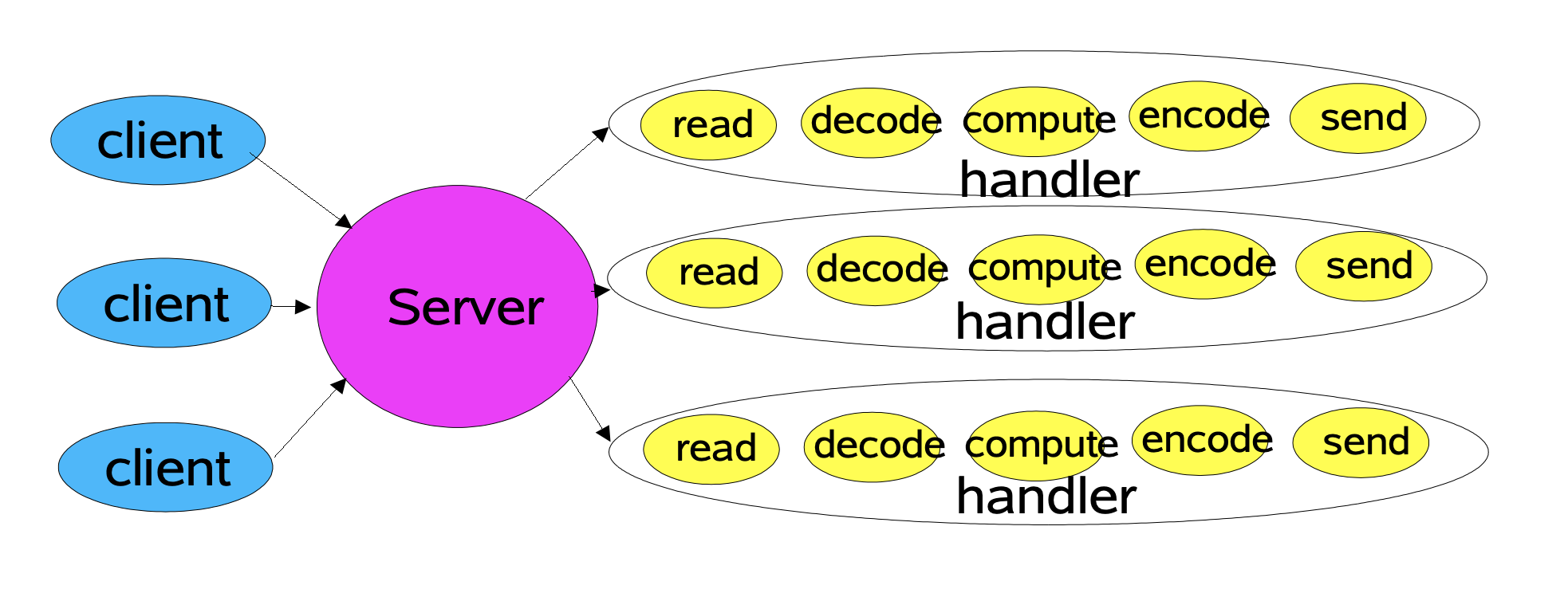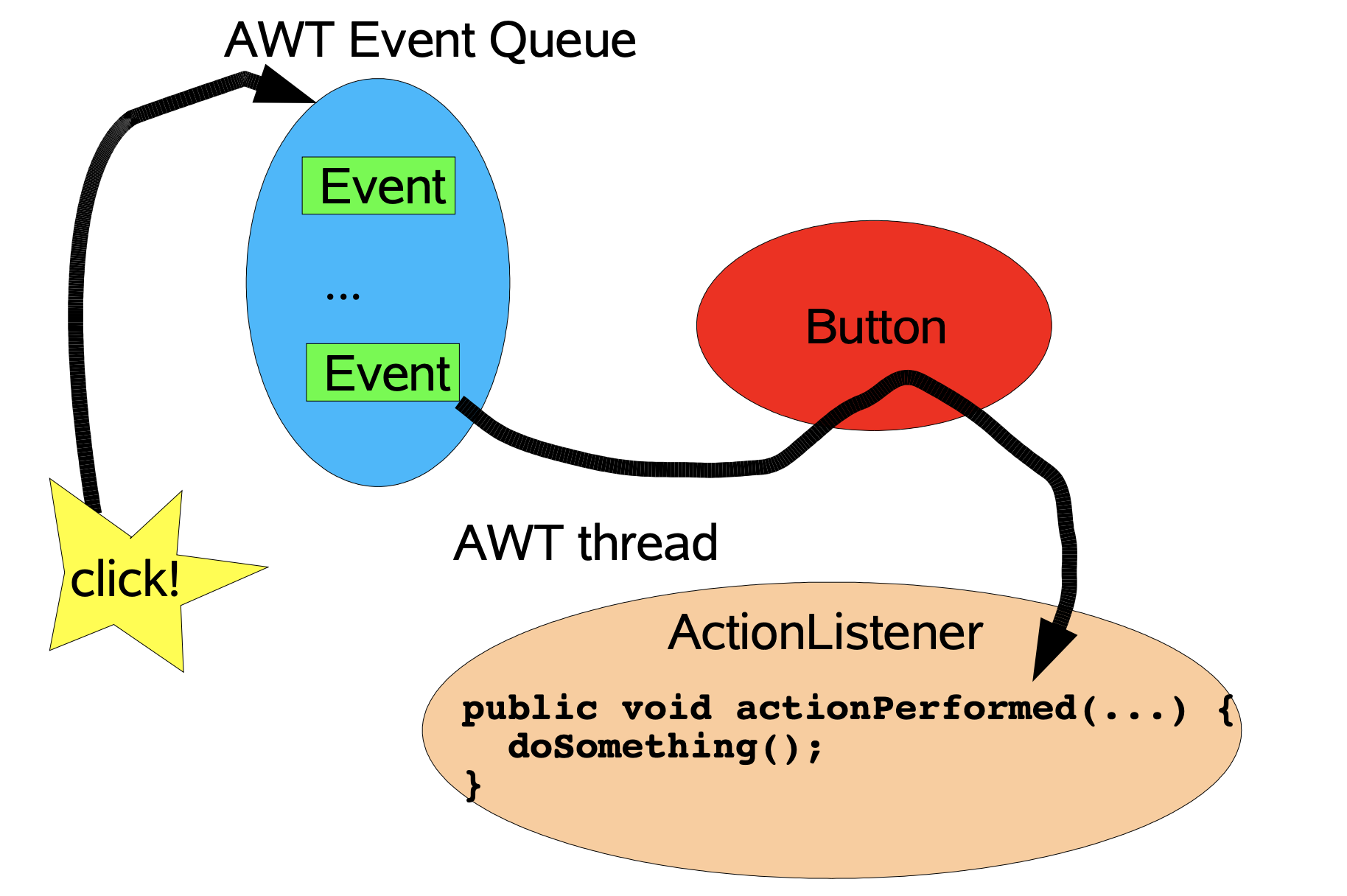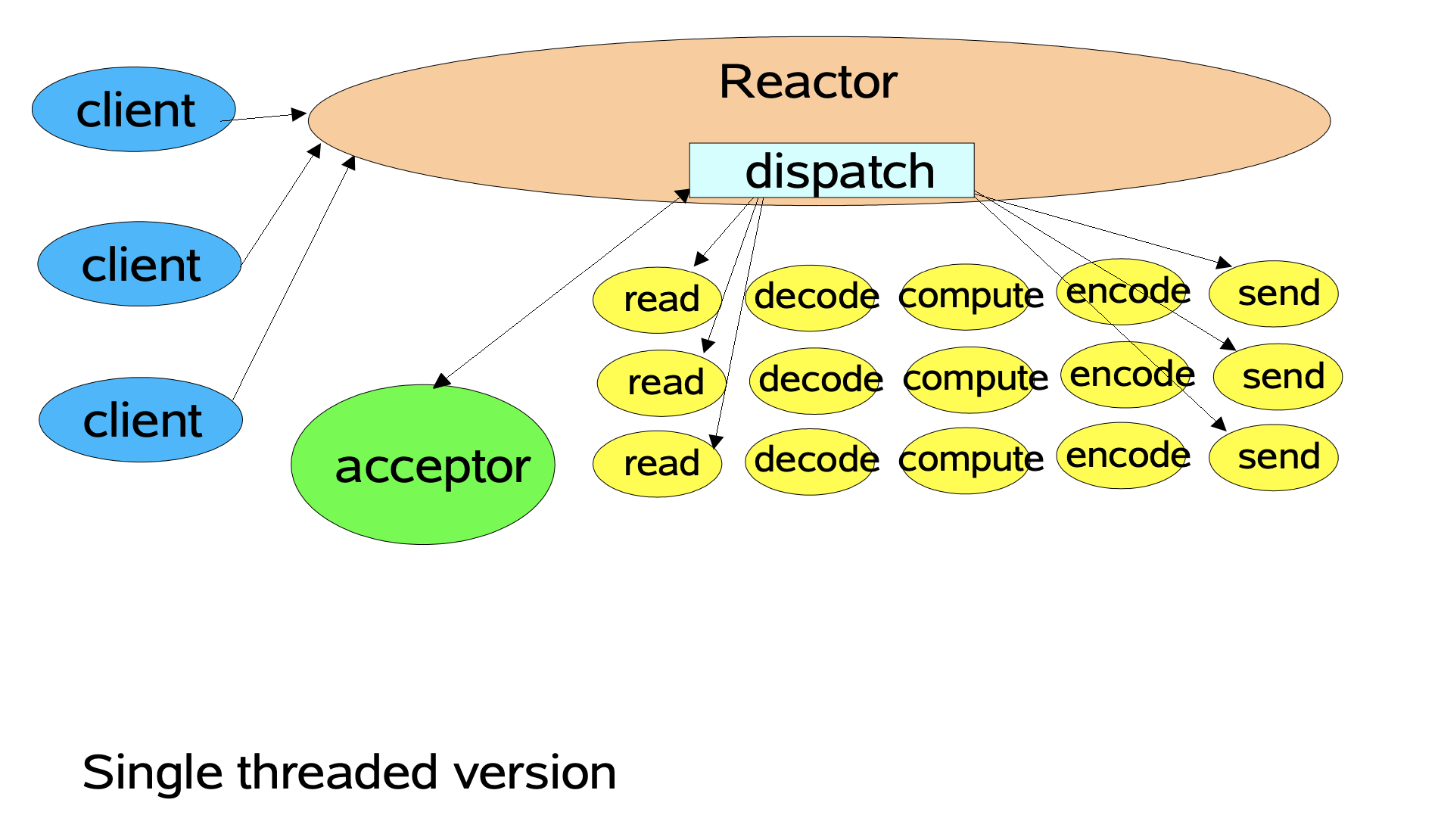本文是Scalable IO in Java 的翻译,旨在了解java中IO的React模式。为了更清晰的理解,我调整了文章的部分顺序。
大纲
事件驱动处理
反应器模式
java nio包非阻塞IO api一览
一、网络服务 Web服务,分布式对象等,大都有相同的结构:
但每一步的性质和成本不同,如Xml解析,文件传输,页面渲染,服务处理,等等。
1. 典型的服务设计
1)每个handler由单独的线程调用执行。
2)典型的ServerSocketLoop程序:
1 2 3 4 5 6 7 8 9 10 11 12 13 14 15 16 17 18 19 20 21 22 23 24 25 26 27 class Server implements Runnable { public void run () { try { ServerSocket ss = new ServerSocket (PORT); while (!Thread.interrupted()) new Thread (new Handler (ss.accept())).start(); } catch (IOException ex) { } } static class Handler implements Runnable { final Socket socket; Handler(Socket s) { socket = s; } public void run () { try { byte [] input = new byte [MAX_INPUT]; socket.getInputStream().read(input); byte [] output = process(input); socket.getOutputStream().write(output); } catch (IOException ex) { } } private byte [] process(byte [] cmd) { } } }
NOTE:代码示例中忽略了异常处理。
2. 可扩展性的目标
负载增加时的优雅降级(更多客户端)
随着资源(CPU、内存、磁盘、带宽)的增加而不断改进(即,可水平扩容)
满足可用性和性能目标
分而治之通常是实现任何可伸缩性目标的最佳方法
将处理划分为小任务,每个任务执行一个动作而不阻塞
任务条件满足时开始执行,通常IO事件作为触发器
二、事件驱动设计
java.nio提供了基础机制的支持来实现可扩展性的目标:
1)非阻塞 的读和写
2)分派 与监听到的IO事件给关联的任务
他们有一系列的事件驱动设计的变种实现,事件驱动IO的思路大致相同,但是实现各有不同。
1. 背景:AWT的事件
2. 事件驱动的优劣
通常比其他方法更有效
通常增加了编程的难度
必须切分为简单的非阻塞任务
类似GUI的事件驱动
无法消除所有的阻塞:GC,页面失效,等
必须跟踪服务的逻辑状态
三、反应器模式(Reactor Pattern) 1. 反应器三部曲
**反应器(Reactor)**对IO事件做出响应,把他们分发给合适的处理器。 类似AWT thread。
**处理器(Handler)**执行非阻塞操作。
把反应器和处理器进行关联。类似AWT addActionListener。
2. java.nio支持
Channels
Buffers
Selectors
SelctionKeys
3. 基础反应器设计
1 2 3 4 5 6 7 8 9 10 11 12 13 14 15 16 17 18 19 20 21 22 23 24 25 26 27 28 29 30 31 32 33 34 35 36 37 38 39 40 41 42 43 44 45 46 47 48 49 50 51 class Reactor implements Runnable { final Selector selector; final ServerSocketChannel serverSocket; Reactor(int port) throws IOException { selector = Selector.open(); serverSocket = ServerSocketChannel.open(); serverSocket.socket().bind(new InetSocketAddress (port)); serverSocket.configureBlocking(false ); SelectionKey sk = serverSocket.register(selector, SelectionKey.OP_ACCEPT); sk.attach(new Acceptor ()); } public void run () { try { while (!Thread.interrupted()) { selector.select(); Set selected = selector.selectedKeys(); Iterator it = selected.iterator(); while (it.hasNext()) dispatch((SelectionKey)(it.next()); selected.clear(); } } catch (IOException ex) { } } void dispatch (SelectionKey k) { Runnable r = (Runnable)(k.attachment()); if (r != null ) r.run(); } class Acceptor implements Runnable { public void run () { try { SocketChannel c = serverSocket.accept(); if (c != null ) new Handler (selector, c); } catch (IOException ex) { } } } }
1 2 3 4 5 6 7 8 9 10 11 12 13 14 15 16 17 18 19 20 21 22 23 24 25 26 27 28 29 30 31 32 33 34 35 36 37 38 39 40 41 42 43 44 45 46 47 final class Handler implements Runnable { final SocketChannel socket; final SelectionKey sk; ByteBuffer input = ByteBuffer.allocate(MAXIN); ByteBuffer output = ByteBuffer.allocate(MAXOUT); static final int READING = 0 , SENDING = 1 ; int state = READING; Handler(Selector sel, SocketChannel c) throws IOException { socket = c; c.configureBlocking(false ); sk = socket.register(sel, 0 ); sk.attach(this ); sk.interestOps(SelectionKey.OP_READ); sel.wakeup(); } boolean inputIsComplete () { } boolean outputIsComplete () { } void process () { } public void run () { try { if (state == READING) read(); else if (state == SENDING) send(); } catch (IOException ex) { } } void read () throws IOException { socket.read(input); if (inputIsComplete()) { process(); state = SENDING; sk.interestOps(SelectionKey.OP_WRITE); } } void send () throws IOException { socket.write(output); if (outputIsComplete()) sk.cancel(); } }
4. 变种 - 状态关联对应处理器 Gof状态模式简单使用,把Handler作为附件绑定给SelectionKey。
1 2 3 4 5 6 7 8 9 10 11 12 13 14 15 16 17 18 19 20 class Handler { public void run () { socket.read(input); if (inputIsComplete()) { process(); sk.attach(new Sender ()); sk.interest(SelectionKey.OP_WRITE); sk.selector().wakeup(); } } class Sender implements Runnable { public void run () { socket.write(output); if (outputIsComplete()) sk.cancel(); } } }
5. 变种 - 多线程设计 1)多线程设计思路
按策略添加线程以实现可扩展性
工作线程
反应器应该快速触发处理器(然后返回)
将非IO处理逻辑转移到其他线程(反应器线程)
多反应器线程
单反应器线程处理IO时,可能会饱和
将负荷分配给其他反应堆
2)多线程 - 工作线程
1 2 3 4 5 6 7 8 9 10 11 12 13 14 15 16 17 18 19 20 21 22 23 class Handler implements Runnable { static PooledExecutor pool = new PooledExecutor (...); static final int PROCESSING = 3 ; synchronized void read () { socket.read(input); if (inputIsComplete()) { state = PROCESSING; pool.execute(new Processer ()); } } synchronized void processAndHandOff () { process(); state = SENDING; sk.interest(SelectionKey.OP_WRITE); } class Processer implements Runnable { public void run () { processAndHandOff(); } } }
3)多线程 - 反应器线程
反应器使用线程池
匹配CPU,IO速率
静态或动态构造
每个反应器有单独的Selector, Thread, dispatch loop
通过Acceptor分发给其他反应器
1 2 3 4 5 6 7 8 9 10 11 Selector[] selectors; int next = 0 ;class Acceptor { public synchronized void run () { ... Socket connection = serverSocket.accept(); if (connection != null ) new Handler (selectors[next], connection); if (++next == selectors.length) next = 0 ; } }
4)任务间协调
传递
每个任务启用、触发或调用下一个任务;这通常最快,但可能很脆弱
回调 - 每个处理器的分发器
队列
Futures
当每个任务产生一个结果时,在join或wait/notify之上分层协调
附:线程池参数
可调节工作线程池
Main method execute(Runnable r)
可设置的参数
任务队列的类型
最大线程数
最小线程数
初始线程
空闲线程的最大存活时间
饱和策略/拒绝策略
6. 使用java.nio的其他特性
每个反应器使用多个Selector
不同的IO事件绑定不同的处理器
需要小心进行同步协调处理
文件传输
内存映射文件(Memory-mapped file)
直接缓冲区
有时可实现零拷贝
但是设置和完成开销很大
最适合长连接的应用程序
7. 基于连接的扩展
替代单次请求
客户端连接
客户端发送批量请求数据
客户端断开连接
示例
可扩展的基础网络模式
处理许多相对长寿命的客户
记录客户端和会话状态
分发服务给多个主机
# 参考
nio.pdf ——doug lea 本仓库副本





